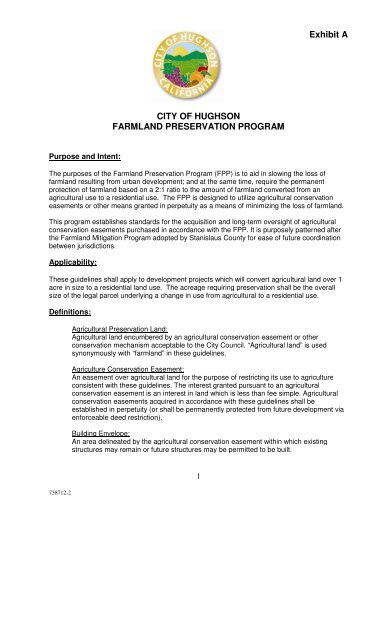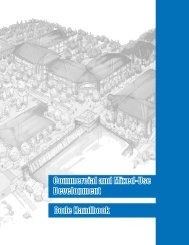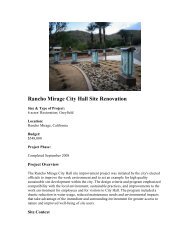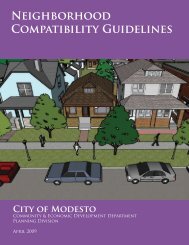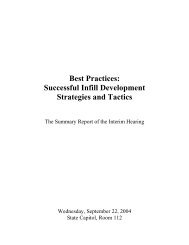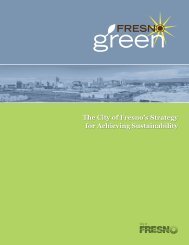Exhibit A CITY OF HUGHSON FARMLAND PRESERVATION PROGRAM
Farmland Preservation Program - the City of Hughson
Farmland Preservation Program - the City of Hughson
Create successful ePaper yourself
Turn your PDF publications into a flip-book with our unique Google optimized e-Paper software.
<strong>Exhibit</strong> A<br />
<strong>CITY</strong> <strong>OF</strong> <strong>HUGHSON</strong><br />
<strong>FARMLAND</strong> <strong>PRESERVATION</strong> <strong>PROGRAM</strong><br />
Purpose and Intent:<br />
The purposes of the Farmland Preservation Program (FPP) is to aid in slowing the loss of<br />
farmland resulting from urban development; and at the same time, require the permanent<br />
protection of farmland based on a 2:1 ratio to the amount of farmland converted from an<br />
agricultural use to a residential use. The FPP P is designed to utilize agricultural conservation<br />
easements or other means granted in perpetuity as a means of minimizing the loss of farmland.<br />
This program establishes standards for the acquisition and long-term oversight of agricultural<br />
conservation easements purchased in accordance with the FPP. It is purposely patterned after<br />
the Farmland Mitigation Program adopted by Stanislaus County for ease of future coordination<br />
between jurisdictions.<br />
Applicability:<br />
These guidelines shall apply to development projects which will convert agricultural land over 1<br />
acre in size to a residential land use. The acreage requiring preservation shall be the overall<br />
size of the legal parcel underlying a change in use from agricultural to a residential use.<br />
Definitions:<br />
Agricultural Preservation Land:<br />
Agricultural land encumbered by an agricultural conservation easement or other<br />
conservation mechanism acceptable to the City Council. “Agricultural land” is used<br />
synonymously with “farmland” in these guidelines.<br />
Agriculture Conservation Easement:<br />
An easement over agricultural land for the purpose of restricting its use to agriculture<br />
consistent with these guidelines. The interest granted pursuant to an agricultural<br />
conservation easement is an interest in land which is less than fee simple. Agricultural<br />
conservation easements acquired in accordance with these guidelines shall be<br />
established in perpetuity (or shall be permanently protected from future development via<br />
enforceable deed restriction).<br />
Building Envelope:<br />
An area delineated by the agricultural conservation easement within which existing<br />
structures may remain or future structures may be permitted to be built.<br />
738712-2<br />
1
738712-2<br />
Development Interest:<br />
The property owner, developer, proponent, and/or sponsor of a discretionary<br />
development project subject to these guidelines.<br />
Land Trust:<br />
A nonprofit public benefit 501(c)(3) corporation or other appropriate legal entity operating<br />
in Stanislaus County for the purpose of conserving and protecting land in agriculture, and<br />
approved for this purpose by the City Council.<br />
Legal Parcel:<br />
A portion of land separated from another parcel or portion of land in accordance with the<br />
Subdivision Map Act. A separate Assessor’s Parcel Number alone shall not constitute a<br />
legal parcel.<br />
Methods of Farmland Preservation: Farmland preservation at a 2:1 ratio shall be satisfied<br />
by using one or more of the following techniques:<br />
1) Where the total land area subject to an application which would result in the conversion<br />
of agricultural land to a residential use, and is less than 20-acres in size, farmland<br />
preservation shall be satisfied by direct acquisition of an agricultural conservation<br />
easement or purchase of banked mitigation credits as set forth in these guidelines.<br />
Payment of an in-lieu mitigation fee may be authorized by the City Council only when the<br />
development interest can show a diligent effort to obtain an agricultural conservation<br />
easement or banked mitigation credits have been made without success. Facts the City<br />
Council may consider in making a decision regarding a request for payment of an in-lieu<br />
fee include, but are not limited to; a showing of multiple good faith offers to purchase an<br />
easement or banked mitigation credits having been declined by the seller(s).<br />
2) Where the total land area subject to an application which would result in the conversion<br />
of agricultural land to a residential use, and is 20-acres or more in size, farmland<br />
preservation shall be satisfied by direct acquisition of a farmland conservation easement<br />
as allowed by these guidelines and the Land Trust’s program. It shall be the<br />
development interest’s sole responsibility to obtain the required easement.<br />
3) Alternative Farmland Preservation Methods - Alternative methods may be authorized by<br />
the City Council provided the land will remain in agricultural use consistent with<br />
this program. Any request for consideration of an alternative Farmland Preservation<br />
Method shall be reviewed by the Planning Commission for consistency with this<br />
program prior to a decision by the City Council.<br />
Direct Acquisition (In-Kind Acquisition):<br />
1) The City Council may approve the acquisition of any agricultural<br />
conservation easement intended to satisfy the requirements of these guidelines.<br />
2) The location and characteristics of the agricultural preservation land shall comply<br />
with the provisions of these guidelines.<br />
3) The development interest shall pay an administrative fee equal to cover the costs<br />
of administering, monitoring and enforcing the farmland conservation easement.<br />
The fee amount shall be determined by the Land Trust and approved by the<br />
City Council.<br />
4) The Planning Commission shall review each agricultural conservation easement<br />
for consistency with these guidelines prior to approval by the City Council. The<br />
Commission shall make a formal recommendation to the City Council for<br />
consideration.<br />
2
In - Lieu Fees: The payment of an in-lieu fee shall be subject to the following<br />
provisions:<br />
1) The in-lieu fee shall be determined case-by-case in consultation with the Land<br />
Trust and approved by the City Council. In no case shall the in-lieu fee be less<br />
than 35% of the average per acre price for five (5) comparable land sales in<br />
Stanislaus County.<br />
2) The in-lieu fee shall include the costs of managing the easement, including the<br />
cost of administering, monitoring and enforcing the farmland conservation<br />
easement, and a five percent (5%) endowment of the cost of the easement, and<br />
the payment of the estimated transaction costs associated with acquiring the<br />
easement. The costs shall be approved by the City Council based on<br />
information relating to the costs provided by the Land Trust.<br />
3) The Planning Commission shall review the final in-lieu fee proposal for<br />
consistency with this program prior to approval by the City Council. The<br />
Commission shall make a formal recommendation to the City Council for<br />
consideration.<br />
4) The City Council shall approve the final amount and other terms of the in-lieu fee.<br />
5) Projects that qualify to pay the in-lieu fee shall be subject to a 2.5% administration<br />
fee.<br />
Use of In-lieu Fees - In-lieu fees shall be administered by the Land Trust in fulfillment of<br />
its programmatic responsibilities. These responsibilities cover, without exception, acquiring<br />
interests in land and administering, monitoring and enforcing the agricultural conservation<br />
easement or other instrument designed to conserve the agricultural value of the land for<br />
farmland preservation purposes and managing the land trust. The location and characteristics<br />
of agricultural preservation land shall comply with the provisions of these guidelines.<br />
Agricultural Preservation Land Credit Banking: preservation land credits may be<br />
banked and utilized in accordance with the following provisions:<br />
1) Purpose - The purpose of establishing a method of banking preservation land<br />
credits is to equalize the imbalance between the acreage size of farmland<br />
suitable, and available, for purchase of farmland conservation easements and the<br />
amount of acreage required to meet a 2:1 ratio.<br />
2) Process - Any project requiring the acquisition of an agricultural conservation<br />
easement in accordance with this program may be approved by the City Council<br />
to bank conservation credits on the acreage in excess of the acreage<br />
required for the original project. The conservation credits shall be held by the<br />
individual/entity purchasing the agricultural conservation easement.<br />
3) Credit Value - Each acre in excess of the required acreage for farmland<br />
preservation may be utilized at a 2:1 ratio to satisfy the conservation<br />
requirements of another development.<br />
4) Negotiations - Negotiations to purchase agricultural preservation land credits<br />
shall not involve the City and shall be subject to free market values. The City<br />
shall make available a contact list of individuals/entities with banked credits on<br />
record. The sale of banked credits shall not alter the terms of the original<br />
farmland conservation easement which generated the credits.<br />
5) Authorization - The City Council shall accept purchased credits upon<br />
738712-2<br />
3
738712-2<br />
receipt of a sales agreement, provided the credits have been banked within<br />
Stanislaus County.<br />
6) Records - The City shall maintain a record of banked credits and purchased<br />
credits to insure the Farmland Preservation Program is maintained whole.<br />
Agricultural Preservation Lands - Locations and Characteristics:<br />
1) Location - Agricultural preservation land shall be: A) located in Stanislaus<br />
County; B) designated Agriculture by the Land Use Element of the Stanislaus<br />
County General Plan; C) zoned A-2 (General Agriculture); and D) located at least<br />
one-half mile outside a Local Agency Formation Commission (LAFCO) adopted<br />
Sphere of Influence of a city.<br />
2) Allowable Uses - Agricultural Mitigation land shall be in conformance with the<br />
Stanislaus County’s A-2 zoning district. Any legal nonconforming use of the<br />
property shall be abandoned prior to execution of the agricultural conservation<br />
easement and shall not be allowed to reestablish except as authorized within a<br />
building envelope. The type of agricultural related activity allowed on<br />
preservation land shall be specified as part of the agricultural conservation<br />
easement and shall not be less restrictive then the A-2 zoning district.<br />
3) Parcel Size - Agricultural mitigation land shall consist of legal parcel(s) of twenty<br />
(20) net acres or more in size. Parcels less than twenty (20) net acres in size<br />
shall only be considered if merged to meet the minimum size requirement prior to<br />
execution of the farmland conservation easement. Any building envelope allowed<br />
by the Land Trust shall not be counted towards the required parcel size.<br />
4) Soil Quality - The agricultural preservation land shall be of equal or better soil<br />
quality than the agricultural land whose use is being changed to nonagricultural<br />
uses. Priority shall be given to lands designated as ‘prime farmland’, ‘farmland of<br />
statewide importance’ and ‘unique farmland’ by the California Department of<br />
Conservation’s Farmland Mapping and Monitoring Program.<br />
5) Water Supply - The agricultural preservation land shall have an adequate water<br />
supply sufficient to support the current agricultural use of the land. The water<br />
rights on the agricultural preservation land shall be protected in the farmland<br />
conservation easement.<br />
6) Previous Encumbrances - Land already effectively encumbered by a<br />
conservation easement of any nature is not eligible to qualify as agricultural<br />
preservation land.<br />
Final Approval:<br />
Final approval of any project subject to this program shall be contingent upon the execution of<br />
any necessary legal instrument and/or payment of fees as specified by this program. Final<br />
approval shall be obtained prior to whichever of the following shall occur first: (1) the issuance of<br />
any building grading or encroachment permit(s) required for development; (2) recording of any<br />
parcel or final subdivision map; or (3) operation of the approved use.<br />
Legal Instruments for Encumbering Agricultural Preservation Land:<br />
Requirement - To qualify as an instrument encumbering the land for agricultural<br />
preservation: 1) all owners of the agricultural preservation land shall execute the<br />
4
instrument; 2) the instrument shall be in recordable form and contain an accurate<br />
legal description of the agricultural preservation land; 3) the instrument shall<br />
prohibit any activity which impairs or diminishes the agricultural productivity of the<br />
agricultural preservation land; 4) the instrument shall protect the existing water<br />
rights and retain them with the agricultural preservation land; 5) the interest in the<br />
agricultural preservation land shall be held in trust by the Land Trust in perpetuity;<br />
6) the Land Trust shall not sell, lease, or convey any interest in the agricultural<br />
preservation land except for fully compatible agricultural uses; and 7) if the Land<br />
Trust ceases to exist, the duty to hold, administer, monitor, and enforce the<br />
interest shall pass to the City of Hughson to be retained until a qualified entity to<br />
serve as the Land Trust is located.<br />
Monitoring, Enforcing, and Reporting:<br />
1) Monitoring and Enforcing - The Land Trust shall monitor all lands and<br />
easements acquired in accordance with these guidelines and shall review and<br />
monitor the implementation of all management and maintenance plans for these<br />
lands and easement areas. It shall also enforce compliance with the terms of the<br />
conservation easement or agricultural preservation instruments.<br />
2) Reporting by the Land Trust - Annually, beginning one year after the adoption<br />
of this program, the Land Trust shall provide to the Hughson City Manager an<br />
annual report delineating the activities undertaken pursuant to the requirements<br />
of this program and assessment of these activities. The report(s) shall describe<br />
the status of all lands and easements acquired in accordance with this program,<br />
including a summary of all enforcement actions.<br />
Stacking of Conservation Easements:<br />
Stacking of easements for both habitat conservation easements on top of an existing agricultural<br />
easement granted in accordance with these guidelines may be allowed if approved by the City<br />
Council provided the habitat needs of the species addressed by the conservation easement<br />
shall not restrict the active agricultural use of the land.<br />
The Planning Commission shall review all stacking proposals to insure the stacking will<br />
not be incompatible with the maintenance and preservation of economically sound and<br />
viable agricultural activities and operations. The recommendation of the Planning<br />
Commission shall be considered by the City Council.<br />
738712-2<br />
5


